Archive for May 2014
Congratulations to a Growing Fiber Farm
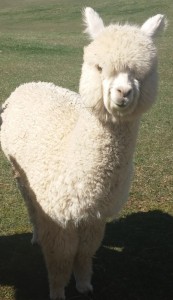
Peaceful Heart's White Owl, preshearing
Congratulations to Renee Lubosch on the addition of our sweet White Owl to her colorful fiber herd. Owl is one of Lord Tennyson’s sons and has the same incredible crimp and dense, soft fleece as all his siblings. Renee was able to take advantage of our pre-shearing sale and purchase Owl and his beautiful fiber, complete with free shearing. She came by to watch him be shorn, then loaded him up in her van for the short ride home.
Shearing is over, but we still have some fabulous alpacas for sale. You can see our saleslists here, then plan a trip to the farm to meet them yourselves. Give us a call, we love to talk alpacas.
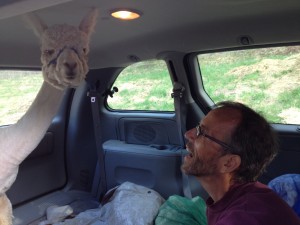
Headed to his new home

It’s A Boy
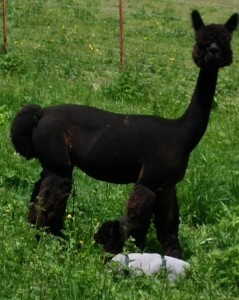
Peaceful Heart's May and Peaceful Heart's Black Ice
Our first spring cria was born on May 17. Peaceful Heart’s Black Ice was born to our lovely, first time mom May and beautiful black herdsire Maximus.
Despite a very cold and difficult beginning, Black Ice is growing well and quite active. He is a gorgeous black, just like both his parents (whose fiber is featured in one of our handwoven shawls). May is the darkest daughter of our fabulous, longtime herdsire Powergrid. Maximus is one of our wonderful new Champion herdsires. His first three crias were born on the farm last year, and they are incredibly consistent in dense, soft fleece, and cute, full fleeced heads (with fuzzy ears).
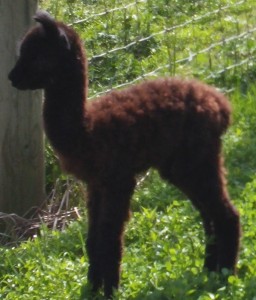
Black Ice at 2 days
You can read more about Black Ice’s rough start and our efforts to save him in our previous post Black Ice is now running around our front pasture near the store, awaiting the birth of some playmates. We hope you can stop by and see him soon.
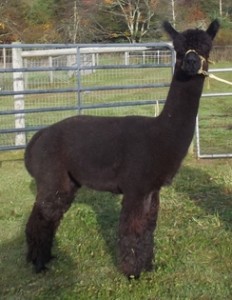
Rivanna Peruvian Maximus

Rough Start
Alpaca births are usually problem free and take about 15-30 minutes from start to finish. We have described many times on our website the after birth process in which the cria immediately works to sit up (usually within 15-30 minutes), stand up (usually within 30-60 minutes), then start nursing successfully (within the first 1-4 hours). Alpacas are livestock, though, and like all livestock occasionally have difficulties after birth. This post will be about what happened when things did not go as well as they usually do.
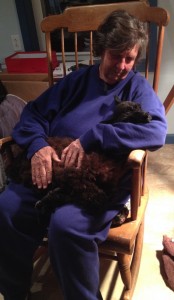 Black Ice was birth number 62 for our farm, and was our first night time birth. Normally, alpacas are particularly thoughtful livestock and give birth between 9 in the morning and 2 in the afternoon (occasionally they stretch it to between 8am-3pm). Among all our births, we’ve only had a couple alpacas born in the early morning before their ‘official’ start time. We have previously never had a night time birth.
Black Ice was birth number 62 for our farm, and was our first night time birth. Normally, alpacas are particularly thoughtful livestock and give birth between 9 in the morning and 2 in the afternoon (occasionally they stretch it to between 8am-3pm). Among all our births, we’ve only had a couple alpacas born in the early morning before their ‘official’ start time. We have previously never had a night time birth.
Saturday May 17, though, that changed for us with the birth of Black Ice. We had been expecting this cria for awhile as May was already at day 366 in her pregnancy (alpaca gestation is normally between 335 and 355 days). We had noticed May was acting like she might be in early labor during the afternoon, so were keeping a close eye on her, though we really expected her to deliver the next day. In one of our trips to the pasture after dark, Mike noticed an odd black lump in the pasture and went out to find a very cold and limp cria. The whole family ran out to help.
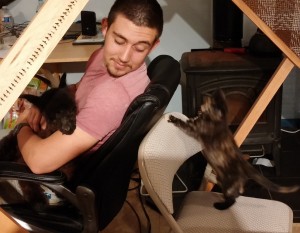
Even kitten had to check out the new cria
Linda grabbed towels and blankets. I wrapped the cria in a blanket and rushed it to the barn while Mike and David haltered a very confused May and brought her along behind. Our listless cria weighed just 10 pounds*, and was too cold, too wet, and barely active or breathing.
.
We followed our normal procedures for a cria born on a cold day and dried with towels and a blowdryer as well as putting a little Karo syrup on his gums to give him some quick energy and took his temperature. Two different thermometers registered ‘low’ rather than giving us a reading, so we were afraid they were both broken. By then, I had decided that I did not have a chance of getting the cria dry and warm in the barn with the outside temperature around 35 degrees. I apologized to May for taking her cria, but knew we had to get him in the house and warm in order to save him.
Once in the house, we turned up the heat, set up a heat lamp and kept blow drying and rubbing with towels. Our little cria was still limp and barely breathing. David suggested putting the cria in a warm tub to bring up his body temperature. We placed him in a plastic bag up to his chin and dipped his body in a warm bath for about 5 minutes. He started to move around and respond for the first time. We removed him from the bath and continued to work on getting him fully dry. We continued to take his temperature, finally getting a reading of 93.6*F (making us realize he had previously been too cold for our thermometer to register) and then saw a steady rise of his body temperature.**
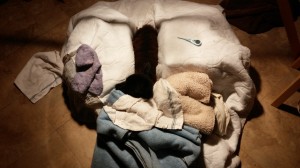
Under the heat lamp
David had been able to express a little colostrum from May, which we gave to the cria. He was still very limp and not responding much, so we used a 3cc syringe and slowly gave him the milk, allowing it to drip down his throat, watching for him to swallow. I continued to give him a little milk at a time throughout the night.
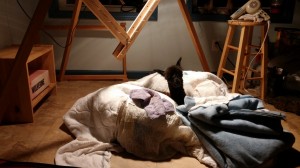 It is important for alpacas to cush upright in order to breath properly, which is why they sleep with their legs tucked under them at night. You will see alpacas sunbathing on their side during a warm, sunny day, but usually not for a long period of time. Our little cria did not have the strength to do so at first, so initially someone held him with his head on her or his shoulder. After we got his temperature higher and him slightly stronger, we rigged up a bed for him under the heat lamp. We propped him between two cases of water and placed a rolled blanket in front of him to keep his head propped up.
It is important for alpacas to cush upright in order to breath properly, which is why they sleep with their legs tucked under them at night. You will see alpacas sunbathing on their side during a warm, sunny day, but usually not for a long period of time. Our little cria did not have the strength to do so at first, so initially someone held him with his head on her or his shoulder. After we got his temperature higher and him slightly stronger, we rigged up a bed for him under the heat lamp. We propped him between two cases of water and placed a rolled blanket in front of him to keep his head propped up.

Ready to go find Mama
This worked well until about 2 a.m. when he decided he was ready to get up and find his mom. I spent the next few hours until sunrise trying to keep him from falling all over the house (next time I’ll put less slippery floors in the house). We quickly bundled him up in two alpaca cria coats and put him in the barn with his very-happy-to-see-him mama. He was ready to nurse and snuggle with her.
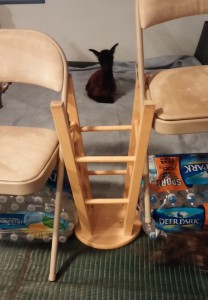
Cria proofing the house
Over the next few days we kept a close eye on little Black Ice and May. May did not appear to have sufficient milk at first, which may have been related to the fact that Black Ice appeared to be dysmature.*** We continued to supplement his feeding and weighed Black Ice twice a day to see how he was gaining weight. We wanted to make sure he was getting enough milk from us that would allow him to continue growing but still be hungry enough to nurse and stimulate milk production in May. Apparently we struck the right balance as within three days we cut back to no feedings and continued to see his weight increase at 0.2 and 0.4 pounds a day.
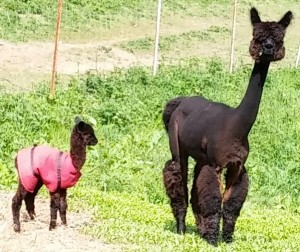
Black Ice and May
Our little Black Ice is now 1 week old and 12.6 pounds (he had dropped to 9.4 pounds the day after he was born). He is very active, and behaving like any other normal alpaca cria. We are still keeping a very close eye on him as he may have some challenges ahead due to his rough start, but feel very hopeful that he will continue to grow and thrive.
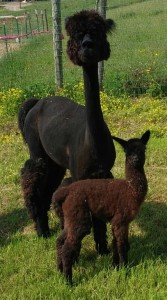
May 25, 2014
============================
============================
* Alpaca crias normally weigh 14-18 pounds. Most of our crias have weighed over 16 pounds. We have never had a cria anywhere near this small.
** Normal alpaca temperature should be 100 to 102* F.
*** A dysmature alpaca cria exhibits the signs of being premature despite being born at full term.

Shearing is Finished
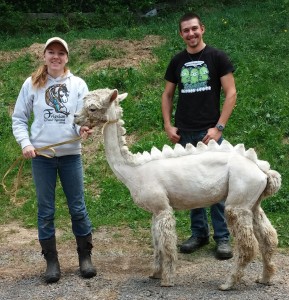
Claire and David with Angelyn the Pacasaurus
We are through with shearing for 2014! After 3 weekends dedicated to shearing our herd of 50 alpacas ages 7 months and up, David and Claire were ready to celebrate. Our last two alpacas to shear were our two oldest girls, 13 year old farm matriarch Lystra and 17 year old Angelyn, who moved to our farm to retire a couple years ago.
.
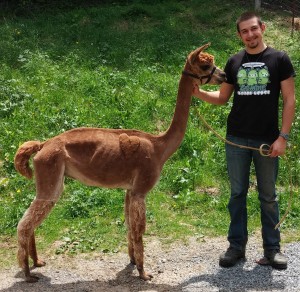
Lystra, showing off her 'peaceful' heart, with David
David was inspired to leave a small heart of fiber on Lystra, to show her farm spirit. David and Claire had bigger plans for Angelyn (preapproved by farm and fiber manager Sharla). Inspired by a photo from fellow alpaca shearer and owner of Fireweed Alpacas Teri Phipps, David proposed they create a stegosaurus cut for our oldest farm member. Angelyn seemed to be in agreement as she patiently waited to get her hair cut and then proudly showed off her fashionable new hairdo. All the other alpacas were quite impressed.
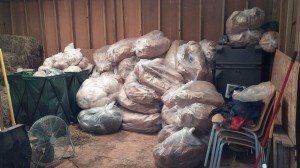
Our fiber for the year, waiting to be sorted
Of course, all the other alpacas received much more traditional cuts, and are looking sleek and ready for summer. David and Claire are still working on shearing for the almost 30 small alpaca farms in the area that they shear for each year, but will finish up by the end of the month. Sharla is ready to start her big job of the year, and tackle the 283 pounds of fiber provided by our lovely alpacas this year. All the fiber must now be sorted to prepare for shows and processing.
If you are interested in purchasing a whole fleece to work with, contact us now as this is the best time to choose your fleece. We have a great selection of colors and fiber grades from which to select.

Fabulous New Alpacas Added to Our Herd
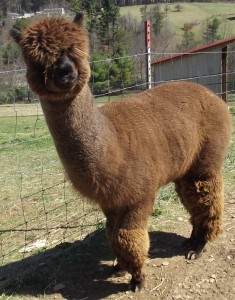
FWD Amaro Khan
I am slow to announce these incredible additions to our farm because we just recently got them moved on to the farm. Some may remember Kubla Khan who was boarding on our farm in 2012 and is the sire of several of our 2013 crias (Augustine, Earlyne, Ninja, and Summer Love). Late last year we had the opportunity to add his fabulous siblings FWD Amaro Khan and FWD Aga Khan’s Cocoabean to our herd. Both are, like Kubla, dark rosegray, multiple Champion alpacas and bring some new genetics and color background to our breeding program.
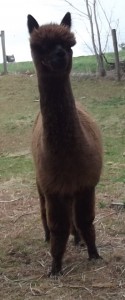
FWD Aga Khan's Cocoabean
Amaro and Cocoabean’s sire is “The Aga Khan,” an 11 time Championship winner and 5 time Get-of-Sire winner. He is descended from Shere Khan possibly the most famous herdsire in Peru, who sired the Vendagor/Capac line. The Aga Khan has many award winning offspring who continue his legacy of success, including these two beauties.
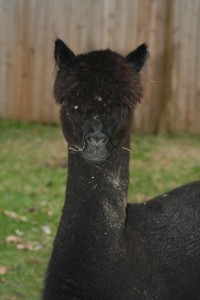
FWD Sharif
We also added a lovely true black, proven herdsire, FWD Sharif, as well as a beautiful trailer and other equipment. All of this came from the wonderful farm of Fireweed Farm Alpacas. We are looking forward to seeing their first crias join our farm this year and next.
